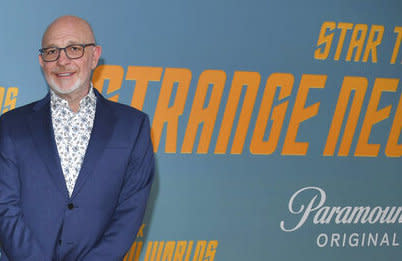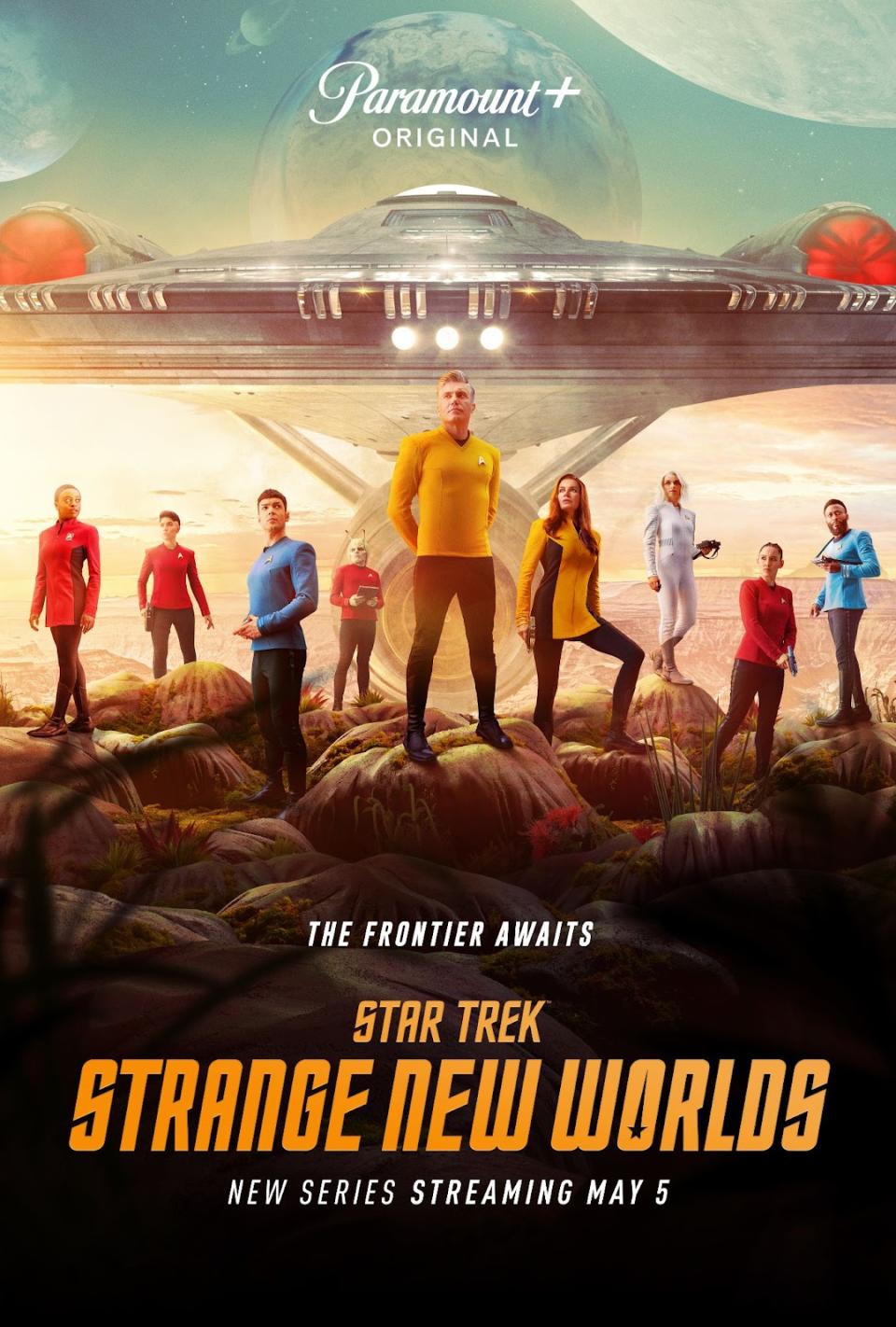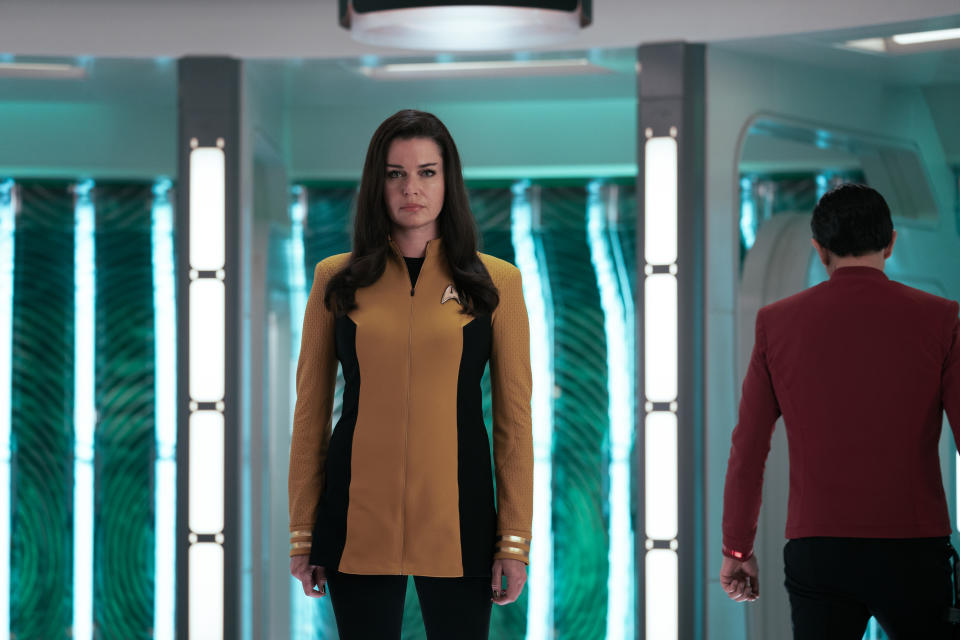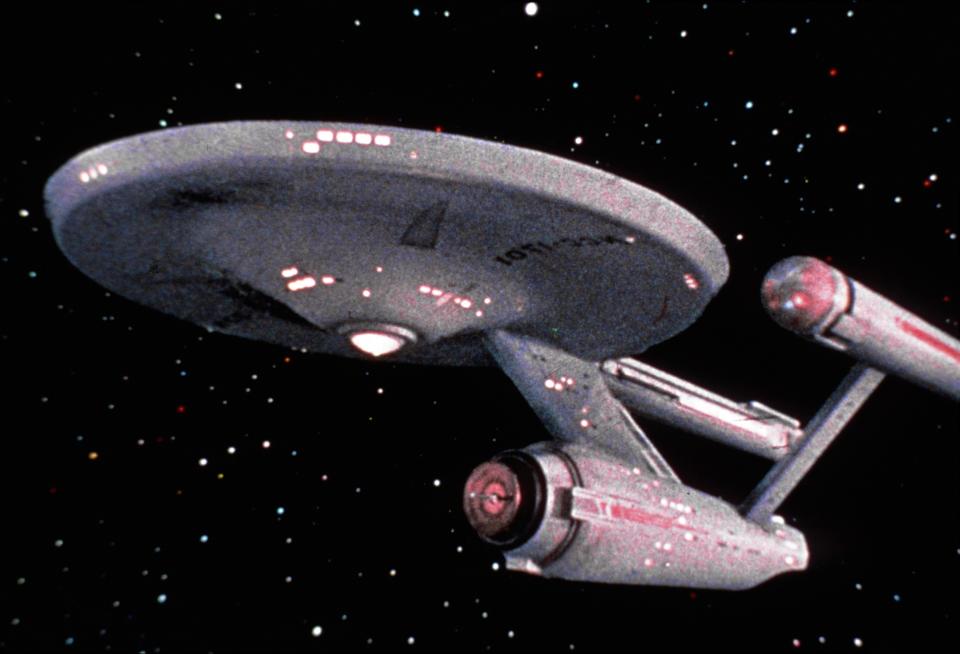‘Star Trek: Strange New Worlds’ Co-Creator Akiva Goldsman On Season 1 Throwback Finale, Crossovers & Where It All Could End
- Oops!Something went wrong.Please try again later.
- Oops!Something went wrong.Please try again later.

SPOILER ALERT: This article contains details of the Season 1 finale of Star Trek: Strange New Worlds that dropped today on Paramount+.
“You and I are of a kind,” proclaims a doomed Romulan commander to USS Enterprise Captain Christopher Pike (Anson Mount) in the reflective Season 1 finale of Star Trek: Strange New Worlds. “In a different reality, I could have called you friend,” he adds in words that resonate through the decades for any fan of the Gene Roddenberry-created franchise.
More from Deadline
That line in the Henry Alonso Myers & Akiva Goldsman-penned episode “A Quality of Mercy” is, of course, directly taken from 1966’s “Balance of Terror,” the acclaimed 14th episode of the first season of the original Star Trek series. Poignant in its repurposing of sorts, the callback flows as a lean forward for the renewed Paramount+ offering.

AP
“We want you to like it for sure, even if you know nothing, but if you know a bunch, then we want you to love it,” says SNW co-creator Goldsman from NYC on the Chris Fisher-helmed finale. “The more you know, the more we want you to love it,” the Oscar winner adds of the multi-level narrative that also saw Mount’s Pike face his own fate and the introduction of Paul Wesley as the latest incarnation of James T. Kirk. “That was particularly true of this finale, because if you know the original episode, then you should be giddy. If you don’t, it should still be cool because it’s talking about contemporary things.”
Juggling such contemporary things in the form of the last-minute arrest of Rebecca Romijn’s Una/Number One, Kirk’s debut, the war to end all wars, a maimed Spock (Ethan Peck) and the different reality that Pike rejects thanks to a chat with his future self and some green Klingon time crystals, the 10th episode of SNW’s inaugural season — which shares its title with a famous 1961 Twilight Zone episode — clearly is the culmination of an origin story with a preordained conclusion.
To that end, Goldsman spoke with me about the Season 1 finale, its many tentacles and what Season 2 could bring. Additionally, the prolific filmmaker also addresses the weaving in and out of Trekverse canon, potential crossovers with the likes of the Patrick Stewart-led Star Trek: Picard and the Sonequa Martin-Green-led Star Trek: Discovery and where he wants it all to go in the end.
DEADLINE: This finale leans heavily into the past and the future, how far are you going to take Strange New Worlds to The Original Series?
GOLDSMAN: Well, we have always been rubbing up against TOS, obviously, not just when it comes to chronological continuity. We’ve done a lot to identify ourselves with TOS, and that’s the episodic nature of the storytelling and the genre jumping that we do.
So it felt like an intersection was owed, at least to ourselves. Very early on we thought, “Well, how are we going to do that? Are we going to do that?” And you know, the “Balance of Terror” episode is this classic moment in Trek-esque lens on society. So who’s the other? What’s the other look like? Is the other us? How do we not, dare I say, alienate those who are different? How do we alienate those who are different, you know? All the stuff that Roddenberry was talking about, which is really tragically equally, at least equally relevant today.
So, there you have “Balance of Terror” sort of sitting there as its own object. It’s like an inflection point for our stuff too, and so we thought, “Well, this is sort of fitting and kind of a delightful possibility,” and so off we went.
DEADLINE: That final scene of Anson’s stare into the camera certainly takes you to that, doesn’t it?

GOLDSMAN: This is sort of a weird thing to say, but it’s a follow-on to the sort of stylistic Easter eggs that are in the episode. We took to heart the eye lights and the crash zoom on Spock, you know, from the original. We did that all the way through to sort of say, to pay tribute, right? Because when we do that thing — and Dom, you and I have talked about this a bunch — where when the modern Star Treks are working best in my view is when they are sort of agnostic.
DEADLINE: How do you mean?
GOLDSMAN: At least in terms of fundamental enjoyment as to whether or not you are a fan of Star Trek.
DEADLINE: What’s the take?
GOLDSMAN: We want you to like it for sure even if you know nothing, but if you know a bunch, then we want you to love it. The more you know, the more we want you to love it. That was particularly true of this finale, because if you know the original episode, then you should be giddy. If you don’t, it should still be cool because it’s talking about contemporary things.
DEADLINE: And the fate, or fates, of Captain Pike, facing the reality of his death, or, I guess or not…
GOLDSMAN: I have said this before, but we wanted to convert it from curse to choice, right? He’s going to pick his future again, and so I guess that look at the end of the finale is, I’m now facing the audience and facing the coming season, parentheses and question mark, hopefully. There’s a lot of what to do now that I know when my life is essentially over.
DEADLINE: In that vein of something being over, “A Quality of Mercy” would have made a great series finale …
GOLDSMAN: That’s a great take, because you have to remember that we made this show before knowing if anybody would like this show. So even though there is a promise of more, right? But at the same time, for me the episode is complete. At the same time, because we are coming back, it does open out into the possibility of continuing story. By the way, now it does actually continue into Season 2, but when we made it, we didn’t know. So it was in its own way our attempt to close off the arc that started it and therefore fundamentally I guess, you know, the idea that if we had been a one season object, we would’ve been proud to end that way.
DEADLINE: So with Christina Chong’s character La’an Noonien-Singh’s leave of absence in the penultimate episode and the arrest of Rebecca Romijn’s Una at the end of the finale, which way is Season 2 heading?
GOLDSMAN: I can’t tell you that, Dom, because that would sort of break Season 2.
DEADLINE: I have no problem with that…
GOLDSMAN: (laughs) But, I will say this about Christina’s character: Something that I was interested in seeing, in a Star Trek context, was trauma. So for La’an, having been raised under tremendous duress, who would she be and how she would be in Starfleet? It was more about what kind of person that created, and it was less about Khan. You know, the Khan thing for me was a little bit more the question of, what is the legacy of the history of Star Trek, right?
Also, there’s this dark moment in the history of Star Trek that leads to the creation of the Federation. So what are the echoes of the darkness or at least of the, again, the fear or the trauma or the loss or the recovery or the resurrection that have also inhabited the lives of those who were born generations after? And so that’s where the Khan thing came in. Then slowly but surely, you know, we started to create how people reacted to La’an, and that’s a little more what’s been leading us down some potential pursuit of her history, but not in the way you think.

Paramount
With Una’s reveal that she is an Illyrian earlier in the season, and genetically modified, we want to touch on it in a real way next season. To actually bring to the foreground at least in a way that’s fulsome, some exploration of marginalization. So this was our opportunity to begin that.
DEADLINE: So you’re on the second season, filming in Toronto. How far do you see Strange New Worlds going?
GOLDSMAN: I mean, I would love for this thing to run right into TOS.
DEADLINE: Really?
GOLDSMAN: Oh, yeah.
DEADLINE: Like, to bang up into real time so you could literally…?
GOLDSMAN: Absolutely.
DEADLINE: Really?
GOLDSMAN: Absolutely. Because here’s the thing. You also … I mean, you know, we’ve already started retconning, you know, what we refer to in the sort of building of the show as Smiley Spock, right — which is the Spock we see in ‘Where No Man Has Gone Before” [the third episode of The Original Series’ first season] and the Spock we would’ve seen in [original TOS pilot] “The Cage” and we see again in [TOS Season 1’s] “The Menagerie,” right? So, ultimately, we should really be able to drive to “Where No Man Has Gone Before.”
DEADLINE: With Picard going into a final season and Discovery on board for more, are we looking at Trekverse crossovers as a part of that larger journey?
GOLDSMAN: I will say only this: We all love the idea of crossovers. So when and if they materialize is still in the air, but we’re looking really hard and we might be able to say yes to that question really soon — at least that’s my hope.

Everett Collection
DEADLINE: Along with that hope to meet up with the Original Series, figuratively and literally?
GOLDSMAN: In the grand scheme of things, there are ways of solving and expanding the scope of the show so that, you know, you keep this group and you start to populate with what we think of as the TOS cast. But this is my pie-in-the-sky idea, right along with my imaginary Star Trek anthology series. These are just the things I think about. There’s literally nothing on the boards about that. It just would be cool.
Best of Deadline
2022-23 Awards Season Calendar - Dates For The Oscars, Emmys, Guilds, Festivals & More
NFL 2022 Schedule: Primetime TV Games, Thanksgiving Menu, Christmas Tripleheader & More
Sign up for Deadline's Newsletter. For the latest news, follow us on Facebook, Twitter, and Instagram.

